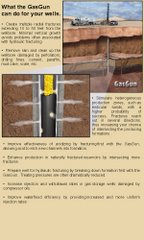In the early 1800's, you would have used far more salt than oil. In fact you would not have much use for oil, but salt was very expensive.
Salt was used to flavor and cure meats. In March, 1829 "American Oil" gushed 50 feet into the air in Burkesville, Cumberland County, Kentucky. The first American gusher flowed for weeks and produced thousands of barrels of oil that flowed into the Cumberland River from Renox Creek. Eventually this well did produce oil for a purpose, but not to heat homes rather for "medicinal" purposes. It was sold under the trade name "American Oil" in glass bottles throughout Europe and the USA.
Two hundred years from now, what will be the commodity that is in high demand? At present oil reigns king, but the prospects of continuously increasing prices and subsequent economic pressure should spur innovation. I am very much in favor of alternative energy sources such as fuel- cells, ethanol, bio-diesel, wind, solar, and nuclear power. I welcome change and have positioned myself in front of many of these trends, but oil continues to be first in my mind as the asset I can profit from. My choice of investment is through direct participation oil/ gas deals or common stocks. The other sectors, other than nuclear, are still in their infancy, thus very aggressive. If I were to invest in these sectors, I would utilize diversified sector funds or unit trusts.
Next week, I will be travelling to the historic area of the Burkesville gusher to look at some shallow producing oil fields. Cumberland County, Kentucky is attractive for drilling because oil can be found at shallow depths above 2000 feet. Based on my discussions with some operators in the area, not much by way of enhanced oil recovery has been tried in this area. It would be nice to introduce some new ideas into an area of oil exploration that is one of the oldest in the USA.
What makes my job as a small operator so exciting is that there are many opportunities to drill in areas that have been proven performers. If I can find leases that have current production and more acreage to drill, I'll apply some modern techniques to increase my odds of hitting a nice well. As discussed in previous articles, hyperspectral imaging combined with side view aerial radar will be a starting point for me to identify "hotspots". Following the satellite images, we will utilize geochemical testing to further refine our focus.
It is amazing to me that after over 175 years of known oil production in a county, I can still unearth opportunities in "American Oil"!
Sunday, August 13, 2006
Subscribe to:
Post Comments (Atom)







No comments:
Post a Comment